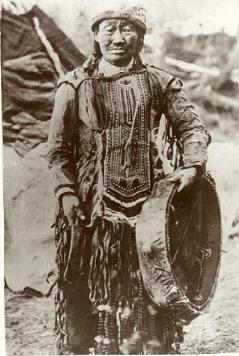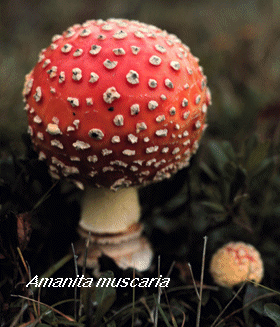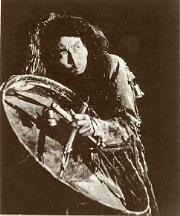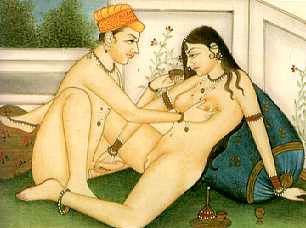|
Rotten Library > Religion > Shamanism
Shamanism If you're going to be religious, you could do a lot worse than being a shaman.
If you're going to be religious, you could do a lot worse than being a shaman. Out of all the various titles of religious authority, only the temple whore can lay claim to having more fun than the shaman, and even that's debatable. The most ancient known tradition of religious authority, shamans access the divine through ecstatic trance. This trance can be achieved through any number of means, including orgiastic sex, chanting, fasting, wild dancing and the ingestion of hallucinogenic drugs. Through one or more of these means, the shaman (often, but not always, male) leaves the confines of his physical body and travels to other, presumably higher realms. During these visionary experiences, the shaman can accomplish any number of useful tasks, such as chatting with the gods, calling down rain, performing Magic and healing the sick. Shamanic traditions date back to prehistoric times, and they can be found in virtually every culture and geographic region in the early history of humanity. The late drug guru Terence McKenna traces the roots of shamanism back to the very beginnings of human consciousness. According to McKenna (whose recreational drug use renders him either biased or especially knowledgeable, depending on your point of view), the earliest humans used hallucinogenic mushrooms to stay tuned into the divine. McKenna argues that the known qualities of psilocybin mushrooms (including sharpened visual acuity at low doses and stimulation of the verbal cortex in larger doses) contributed to the evolution of first humans. Under this view, the hallucinogenic/shamanic experience was pretty democratic to early humans.
In primitive village- and town-based cultures, the shaman was someone who stood a few steps apart from the rest of the community. He was respected and sought-after for his wisdom and supernatural abilities but he wasn't a sought-after guest at dinner parties. In Northern Africa, where humans are generally thought to have first evolved, early religions strongly favored the shamanic approach to dealing with the often harsh weather conditions (especially they moved into regions adjoining the original fertile valleys). African cultures developed a system of beliefs in deities known as obeah, who later developed into the loa venerated by practitioners of Voudoun, itself a shamanic tradition. They also developed the first early cosmologies, based on shamanic visions. Interestingly, shamanic visions have some common elements, no matter what culture they originate with. These include the concepts of upper and lower realms, on other "astral planes" (or as we would say now, "higher dimensions"). The visions also tend to detail a hierarchy of entities, whether gods, angels, animal spirits, ancestral spirits and/or other critters entirely. Shamanic planes are also usually described as being outside of time, removed from the normal passage of time in some inherent way. The symbols and images used to describe these levels of existence tend to be similar, often involving shapes that are based in Sacred Geometry, such as spirals, pyramids and cross-pieces. This may be due to the fact that human consciousness, brain chemistry and neural structures are organized along fairly consistent lines, regardless of culture. And, according to your preference, you may also wish to consider the possibility that these visions are accessing some universal truth. Stranger things have happened.
The practice of shamanism changed regionally, based on climate and indigenous plant life. In Ireland and Britain, the hallucinogenic aspect of the tradition receded due to the relatively less common occurrence of hallucinogenic plants. Shamanic traditions instead geared around the sharp seasonal changes in the islands. In Russia, shamanic traditions survived until late in history, using the Amanita muscaria mushroom and other indigenous plants. In Australia, some milder hallucinogenic drugs were used in conjunction with the ecstatic singing/storytelling tradition of dreamtime. In the Americas, on the other hand, a rich indigenous supply of powerful hallucinogens created potent drug-based shamanic traditions, some of which survive today. The most renowned of these substances was the South American brewed drink known as ayahuasca, also known as yage. Ayahuasca is a mix of hallucinogenic plants brewed according to a traditional recipe. The most important active ingredient is dimethyltryptamine, DMT, which is an extremely powerful hallucinogen. DMT is found in trace amounts in the normal human brain and is easily metabolized. Visions experienced under the influence of DMT tend to be very consistent, especially when ingested with the same recipe, resulting in very similar sets of beliefs among various South American native tribes in the Amazon and elsewhere. In North America, especially the West, peyote served the same sacred purpose (while requiring less preparation). Tobacco was also used as a ceremonial drug, but it's obviously much less effective at creating a visionary state without elaborate accompanying rituals.
In shamanism, the goal of obliterating the ego is often achieved through physical means. The rituals used to invoke shamanic ecstasy in the absence of powerful native hallucinogenic plants tend to have some common elements. Some sort of intoxicant, even non-hallucinogenic, is often part of the mix, and strenuous or monotonous physical activities help modulate the shaman's brain waves into a trance state. In Voudoun, for instance, one practice involves dancing until the point of exhaustion. By losing the self in physical activity, the "divine" is contacted. In Tibetan shamanic traditions, chanting and yoga are used to force self-awareness from the mind. Tantric disciplines in Hindu and Buddhist regions of Southeast Asia are an outgrowth of earlier shamanic practices, in which the self is obliterated during the moment of orgasm. The feats of sexual amazement performed in tantra are geared toward achieving this loss of self, rather than simply impressing one's friends. By extending the moment of orgasm and engaging in intercourse for heroic intervals, the practitioner extends the length of time that the divine is manifest. Not to mention winning one's self an enviable reputation. At the opposite end of the spectrum, asceticism can be used to achieve much the same effect as orgiastic sex. By depriving the body of comforts and even food or water, a shaman can detach from physical form and ascend to the higher realms.
The growth of cities and hierarchical civilization tends to destroy shamanic culture, since political might tends to run roughshod over the sort of individual empowerment represented by shamanism, but a recent resurgence of interest in archaic religious practices has led to the development of new brands of shamanism tailored toward a 21st century mindset. In the place of (or sometimes in conjunction with) psychedelic drugs, computer animation and optical effects are being used by modern cybershamans, who attempt to employ technology as a new vehicle for reaching other planes. While not as viscerally rewarding as a drug-soaked orgy, the use of computers to travel into astral realms is decidedly less messy and requires little in the way of socialization skills, making it an ideal pursuit for pasty-faced Web-surfing geeks glued to their computers, like... well, let's be frank, we're talking about you. People who read Web sites like this one for hours on end. And, I suppose, the people who make those Web sites. 'Scuse me, while I kiss the sky...
|
 Whether or not this was the case during prehistory, the nature of shamanism had begun to mutate once early societies evolved to the point of organized language and record-keeping. The pursuit of ecstatic visions is a lonely one. The people who are best at it tend to have trouble with normal socialization, whether by virtue of their special insights or a predisposition to mental illness.
Whether or not this was the case during prehistory, the nature of shamanism had begun to mutate once early societies evolved to the point of organized language and record-keeping. The pursuit of ecstatic visions is a lonely one. The people who are best at it tend to have trouble with normal socialization, whether by virtue of their special insights or a predisposition to mental illness.  After humans spread around the globe, shamanic traditions spread with them. They are universal in early human cultures, all across Asia, Europe, the Americas, Africa, Australia... Everywhere humans went, they took the tradition with them.
After humans spread around the globe, shamanic traditions spread with them. They are universal in early human cultures, all across Asia, Europe, the Americas, Africa, Australia... Everywhere humans went, they took the tradition with them.  The state of the ecstatic visionary always involves some degree of dissolution of self-awareness. Almost every religion includes this element to a greater or lesser extent, such as the recitation of the rosary in Catholicism or the expansion of through yoga.
The state of the ecstatic visionary always involves some degree of dissolution of self-awareness. Almost every religion includes this element to a greater or lesser extent, such as the recitation of the rosary in Catholicism or the expansion of through yoga.  You might think it's an easy choice between orgiastic sex and starving yourself to death, but different strokes for different folks. Aside from cultural mores and obstacles, and the risk of pregnancy and disease, climate is often a determining factor in shaping the rituals used to achieve shamanic ecstasy. After all, an orgy is good fun, but it can be dangerous in the freezing cold of the Himalayas or the searing heat of the Sahara. Suddenly a few hours of chanting doesn't seem like such a bad idea.
You might think it's an easy choice between orgiastic sex and starving yourself to death, but different strokes for different folks. Aside from cultural mores and obstacles, and the risk of pregnancy and disease, climate is often a determining factor in shaping the rituals used to achieve shamanic ecstasy. After all, an orgy is good fun, but it can be dangerous in the freezing cold of the Himalayas or the searing heat of the Sahara. Suddenly a few hours of chanting doesn't seem like such a bad idea.